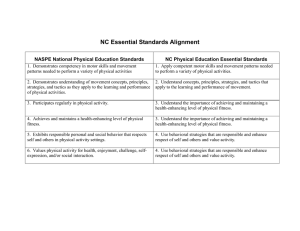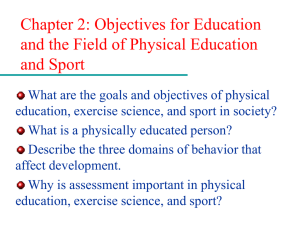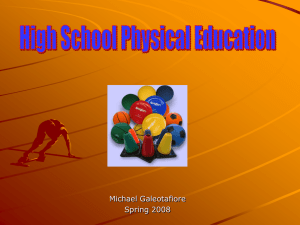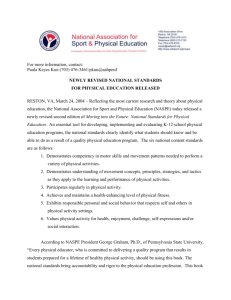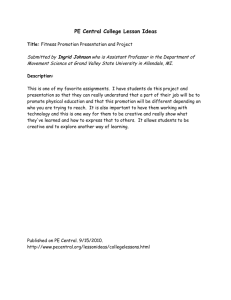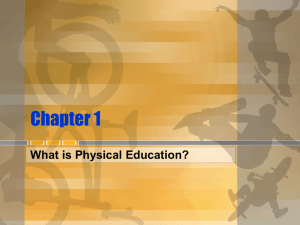NASPE
advertisement
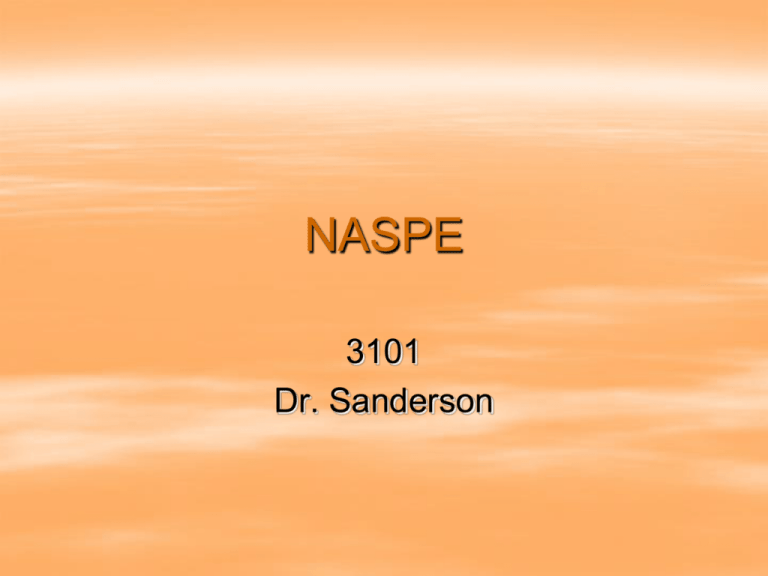
NASPE 3101 Dr. Sanderson How NASPE came about Pres. George H. W. Bush 1989 – Est. National Education Goals Panel – All students should be able to reach the standards and goals set – Goals 2000: Educate America Act March 1994 Written into Federal Law 1995 NASPE was first published NO Child Left Behind Act of 2001 Became law in Jan. 2002 Public Law 107-110 Reaffirmed in 2004 to include physical education. Current Health Concerns Among children and adolescents, annual hospital costs related to overweight and obesity more than tripled over the past two decades – rising to $127 million during 1997–1999, up from $35 million during1979–1981. Among children and teens ages 6-19, 16 percent (over 9 million) are overweight according to the 1999-2002 data, or triple what the proportion was in 1980. Physical Inactivity Stoke Heart disease High BP Osteoporosis Cancer Diabetes Depression Obesity Inactivity/Poor diet Causes at least 300,000 deaths a year in the US – More than the # of deaths caused by infectious diseases, firearms, motor vehicle crashes, and illicit drug use combined NASPE Standards – Define student learning, what a student should know and be able to do as a result of a quality physical education program. – Demonstrate PE has meaningful and significant content. – Justifies the academic standing and inclusion of PE in the curriculum – Brings accountability and rigor to our profession Assessment The process of gathering evidence about a student’s level of achievement in a specified task and making inferences based on that evidence for a varied of purposes It is the “glue” that holds framework standards together. Assessment Should – Reflect the subject content that is most important for the students to learn – Enhance learning through a connection with instruction – Provide reliable evidence of student performance – Yield valid inferences about student learning Assessment Using assessment only for grading is inappropriate assessment practices. Assessment should be seen as the enhancement of learning, rather than simply the documentation of learning. Should be dynamic and continuous, yielding information about student progress toward the achievement of the content standards. Guides teaching, enhances learning, documentation As a Physical Educator Help students develop knowledge and skills for participation in physical activities safely, competently, and with personal satisfaction. Help all students develop health-related fitness, physical competence, cognitive understanding, and positive attitudes about physical activity. Quality Physical Education Programs They provide learning experiences that meet youngsters’ developmental needs, which helps to improve mental alertness, academic performance, and readiness and enthusiasm for learning. Are needed to increase the physical competence, health-related fitness, selfresponsibility and enjoyment of physical activity. Quality PE programs should Increase skill development Improve physical fitness Support other subject areas (integrated lessons) Improve self discipline Improve judgment Reduce stress Strengthen peer relations Improve self-confidence and self esteem Assist in goal setting NASPE content Instruction using a variety of motor skills that are designed to enhance the physical, mental, and social/emotional development of every child. Fitness education and assessment to help children understand, improve, and/or maintain their physical wellbeing. Dev. cognitive concepts about motor skills and fitness. Opportunities to improve students emerging social and cooperative skills and gain a multicultural perspective Promote reg. amts of appropriate physical activity now and throughout life. Appropriate Instruction Max. practice opportunities for class activities. Out-of-school assignments that support learning, practice, and est. life-long habits. Do not use physical activity as a punishment Use assessment to monitor, reinforce, and plan for student learning. Activity Guidelines The recommendation for children 5-12 years of age is at least 60 min. a day (unstructed). NASPE has also produced (2002) guidelines for babies, infants, and toddlers. The 6 National Standards for Physical Education A physically educated person: – Standard 1: Demonstrates competency in motor skills and movement patterns needed to perform a variety of physical activities. Dev. Physical skills needed to enjoy participating Masters movement fundamentals Est. a foundation to facilitate continued motor skill acquisition Capacity for successful and advanced levels of performance – Standard 2: Demonstrates understanding of movement concepts, principles, strategies, and tactics as they apply to the learning and performance of physical activities. Enhances the mind to control or direct one’s performance. Applying concepts form disciplines such as motor learning and development, sport psychology and sociology, and biomechanics and exercise physiology. – StandarParticipates regularly in physical activity. d 3: Connects what one does outside the classroom Standard 4: Achieves and maintains a healthenhancing level of physical fitness. – Dev. Students knowledge, skills, and willingness to accept responsibility for personal fitness, leading to an active, healthy lifestyle. – Dev higher levels of basic fitness and physical competence for many work situations and active leisure participation. – Improvement of the health-related fitness components (cardiorespiratory endurance, muscular strength and endurance, flexibility, and body composition). Standard 5: Exhibits responsible personal and social behavior that respects self and others in physical activity settings. – Assist in the achievement of self-initiated behaviors that promote personal and group success in activity settings. These include safe practices, adherence to rules and procedures, etiquette, cooperation and teamwork, ethical behavior, and positive social interaction. Standards cont Standard 6: Values physical activity for health, enjoyment, challenge, selfexpression, and/or social interaction. – Dev awareness of the intrinsic values and benefits of participation in physical activity that provides personal meaning. – Self-confidence, positive self-image

